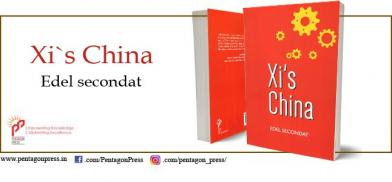Xi’s China is a must-read book
The simple two-worded title of this book Xi’s China is hugely suggestive of the fact that it is the worst version of China in the world so far

The simple two-worded title of this book Xi’s China is hugely suggestive of the fact that it is the worst version of China in the world so far. Worst because even the experimentation of biological weapons, which has been continuing under the policy of the Chinese Communist Party (CCP) for decades, contaminated more than the whole world. Even if this happened accidentally, it is bad enough because even experimentation of such weapons is reprehensible. But there is a strong suspicion that what emanated from the Wuhan Institute of Virology was a bioweapon - COVID-19 and possibly being experimented in many other Chinese laboratories, all with a presence of Peoples Liberation Army (PLA). This is strongly suspected as there was hardly any deadly global effect of COVID-19 in Beijing and Shanghai. The virus spread to 219 countries. The domino effect on the world has been an economic breakdown with millions losing their livelihoods.
Xi substantially stepped up China’s aggressive military consolidation of its planned ‘global domination. Beginning with India, the PLA made the greatest and most grotesque of attempts at grabbing more Indian territory than already grabbed since Aksai Chin. The PLA used medieval barbaric weapons to attack Indian troops and received its second and third rude shock since 1967 from the Indian Army.
With an insightful foreword by Ram Madhav Varanasi, member, governing body, India Foundation, and former general secretary, Bharatiya Janata Party (BJP), the book’s ten chapters under three parts are: An endangered utopia, From paper money to liquor money, Social credit, Schooling system Economics, An exam to rule them all, Filial piety, Empty China, ID, Chinese keyboard and Communism as an accident.
The author, who lived in China from 2010 to 2020 and traveled widely and interacted with people, has made some profound observations, including those on important social issues and how they have impacted the people. There is so much happening in China, which does not get known, thanks to CCP’s total control of the media. Secondat has very well encapsulated a wide array of subjects/issues, revealing much about the Chinese public, into a very reader-friendly paperback. The titles of the chapters are telling enough and should attract readers and institutions to get this book.
The chapter Empty China begins with a mention of Wuhan. Shortly after the ‘outbreak’ of COVID-19, it was reported by foreign media, despite CCP’s efforts to keep everything under wraps and carry on with its propaganda, that tens of thousands of telephone connections went silent and the number of funerals was a major indication of the loss of life. By early 2020, the Wuhan Institute of Virology was reported to be empty/locked with its entire staff untraceable. Also in this chapter, the author dwells on how lockdown/curfew/restrictions have caused many problems for the various industries, including cinema, publishing, printing, and more.
Secondat also brings out the transformation that has come with the internet, digitization, and great infrastructural development. And while he sees great potential for progress for the people in the post-pandemic future, whenever that may be, but which will be denied to them, as he expects the CCP to maintain its tight leash. What has been completely suppressed in China is how callously the CCP treats China’s ordinary citizens, how it runs concentration camps of Tibetans and Uighurs, how cruelly it has repressed and silenced millions suffering from COVID-19 and what the actual death count is.
One of the author’s disconcerting observations in the chapter Empty China throws light on the Chinese way of life. It is indeed disconcerting. He states that despite the size of its population, “China remains most of the time an empty country. An enormous amount of infrastructure has been built during these last years but it looks desperately empty. This is the consequence of a deadly cultural policy that consists of building wonderful cultural infrastructure while impeding cultural activity for political reasons. Hence buildings remain widely underused.”
Just over 150 pages, and at a modest price, the author has given an insightful analysis of CCP ‘s actions/tendencies, how they have impacted the lives of the people and how peoples’ outlook is changing. For all China watchers, it is a good updating primer and can also be enjoyed even by keen readers. It is a must-read for politicians, diplomats, bureaucrats, armed forces, intelligence and police services, think-tanks, and universities and is also worth translating into other languages.
(Xi’s China by Edel Secondat; Published by Pentagon Press with India Foundation; Pages 158 (in paperback), Price Rs. 395)
(The writer is a former spokesperson, Indian Army and Ministry of Defence. He can be contacted at wordsword02@gmail.com)









Post a Comment